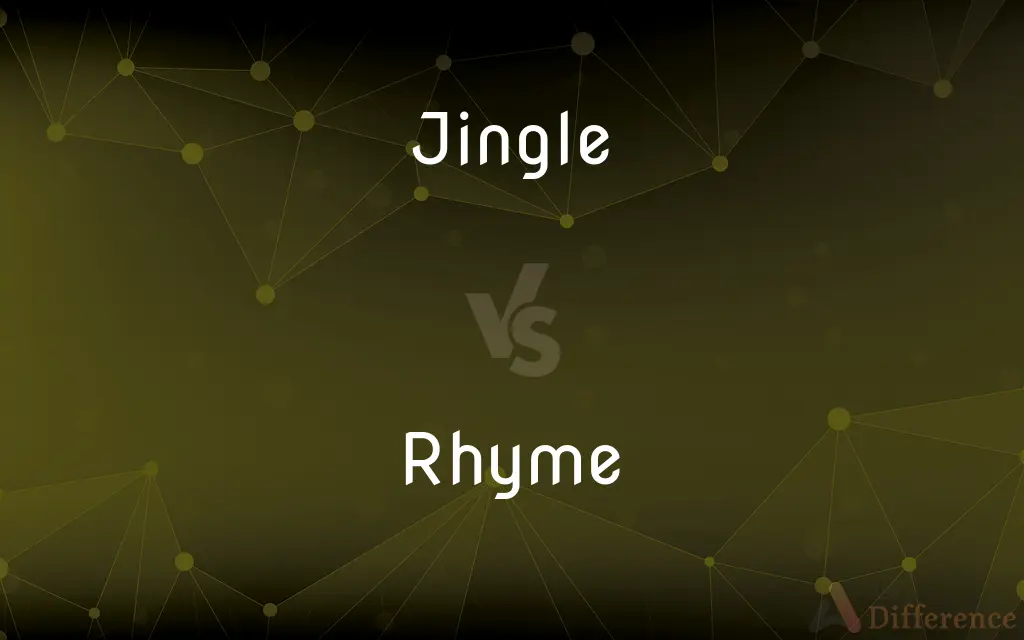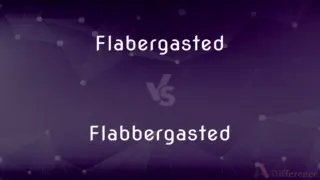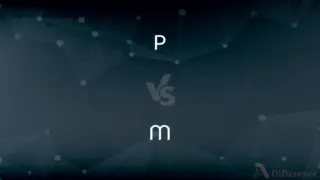Jingle vs. Rhyme — What's the Difference?
By Urooj Arif & Maham Liaqat — Updated on March 6, 2024
A jingle is a catchy, musical advertisement designed to promote a product or service, while a rhyme is a repetition of similar sounding words, often used in poetry and songs.

Difference Between Jingle and Rhyme
Table of Contents
ADVERTISEMENT
Key Differences
Jingles are short, memorable melodies or songs specifically crafted for advertising purposes. They aim to engrain a product, service, or brand in the listener's memory through catchy music and lyrics. On the other hand, rhymes involve the repetition of similar sounds in the final syllables of words, typically at the end of lines in poems or songs. Rhyming is a literary device used to enhance the rhythmic quality and aesthetic appeal of language.
While jingles are primarily commercial and designed to persuade or remind consumers about a brand, rhymes can serve various purposes, including artistic expression, storytelling, or teaching. Rhymes are fundamental to many forms of poetry and are appreciated for their linguistic beauty and mnemonic power, whereas jingles are crafted to capture attention and promote brand recall.
Jingles often incorporate rhymes to make the advertisement more engaging and memorable. However, the primary goal of a jingle is commercial effectiveness, contrasting with rhymes that may aim to evoke emotions, convey messages, or simply entertain. Rhymes are used in a broader context beyond advertising, including literature, songs, and educational materials to facilitate learning and recall.
Despite their differences, both jingles and rhymes rely on the power of sound patterns to make language memorable. Jingles leverage the catchy and repetitive nature of rhymes within a musical framework to achieve commercial objectives, while rhymes enrich the texture and enjoyment of language in various communicative contexts.
Jingles are a marketing tool designed to promote commercial interests through music and catchy lyrics, often employing rhymes for effectiveness. Rhymes, however, are a broader linguistic and literary technique that enhances the rhythm, beauty, and memorability of language across various forms of expression.
ADVERTISEMENT
Comparison Chart
Definition
A catchy, musical advertisement.
Repetition of similar sounds in words.
Purpose
To promote products or brands.
To enhance language rhythm and aesthetics.
Context
Advertising.
Poetry, songs, educational materials.
Primary Goal
Brand promotion and recall.
Artistic expression, entertainment.
Characteristics
Catchy melodies, commercial intent, often rhymes.
Repetition of sounds, used for effect.
Compare with Definitions
Jingle
A short, catchy song or tune used in advertising.
The cereal's jingle has become iconic.
Rhyme
A feature of language play and creativity.
She enjoys creating rhymes for fun.
Jingle
A song that embodies a brand's identity.
The jingle captured the essence of the brand.
Rhyme
A poetic device to create rhythm and aesthetic pleasure.
The poet used rhyme to enhance the verse's flow.
Jingle
Music specifically created for commercials.
He writes jingles for major brands.
Rhyme
Matching of final sounds in different words.
The rhyme scheme added structure to the poetry.
Jingle
An advertisement delivered through song.
The jingle was catchy enough to go viral.
Rhyme
The repetition of similar sounding ends of words.
Sky and high rhyme in the poem.
Jingle
A melody designed to be easily remembered.
The jingle played in every commercial break.
Rhyme
A tool for memorization and learning.
Rhymes help children remember the alphabet.
Jingle
A jingle is a short song or tune used in advertising and for other commercial uses. Jingles are a form of sound branding.
Rhyme
A rhyme is a repetition of similar sounds (usually, exactly the same sound) in the final stressed syllables and any following syllables of two or more words. Most often, this kind of perfect rhyming is consciously used for artistic effect in the final position of lines within poems or songs.
Jingle
To make a tinkling or ringing metallic sound.
Rhyme
Correspondence of sound between words or the endings of words, especially when these are used at the ends of lines of poetry
Poetic features such as rhythm, rhyme, and alliteration
Jingle
To have the catchy sound of a simple, repetitious rhyme or doggerel.
Rhyme
(of a word, syllable, or line) have or end with a sound that corresponds to another
Balloon rhymes with moon
Jingle
To cause to make a tinkling or ringing metallic sound.
Rhyme
Correspondence of sounds at the ends of words or phrases, especially when involving the last stressed vowel and all succeeding sounds in each of two or more such words or phrases.
Jingle
The sound produced by or as if by bits of metal striking together.
Rhyme
A word that exhibits such correspondence with another, as behold and cold.
Jingle
A piece of light singsong verse or rhyme.
Rhyme
A poem or verse employing such correspondence as a formal feature, especially at the ends of lines.
Jingle
A catchy, often musical advertising slogan.
Rhyme
Poetry or verse of this kind.
Jingle
The sound of metal or glass clattering against itself.
He heard the jingle of her keys in the door and turned off the screen.
Rhyme
To form a rhyme.
Jingle
(music) A small piece of metal attached to a musical instrument, such as a tambourine, so as to make a jangling sound when the instrument is played.
Her tambourine didn't come with any jingles attached.
Rhyme
To compose rhymes or verse.
Jingle
A memorable short song, or in some cases a snippet of a popular song with its lyrics modified, used for the purposes of advertising a product or service in a TV or radio commercial.
That used-car dealership's jingle has been stuck in my head since we heard that song.
Rhyme
To make use of rhymes in composing verse.
Jingle
A carriage drawn by horses.
Rhyme
To put into rhyme or compose with rhymes.
Jingle
(slang) A brief phone call; a ring.
Give me a jingle when you find out something.
Rhyme
To use (a word or words) as a rhyme.
Jingle
A jingle shell.
Rhyme
Rhyming verse (poetic form)
Jingle
Coin money.
Rhyme
A thought expressed in verse; a verse; a poem; a tale told in verse.
Jingle
Pee, urine.
Rhyme
(countable) A word that rhymes with another.
Jingle
(intransitive) To make a noise of metal or glass clattering against itself.
The beads jingled as she walked.
Rhyme
A word that rhymes with another, in that it is pronounced identically with the other word from the vowel in its stressed syllable to the end.
Jingle
(transitive) To cause to make a noise of metal or glass clattering against itself.
She jingled the beads as she walked.
Rhyme
(uncountable) Rhyming: sameness of sound of part of some words.
Jingle
To rhyme or sound with a jingling effect.
Rhyme
(linguistics) rime
Jingle
To pee, to urinate.
Rhyme
(obsolete) Number.
Jingle
To sound with a fine, sharp, rattling, clinking, or tinkling sound; as, sleigh bells jingle.
Rhyme
(ambitransitive) To compose or treat in verse; versify.
Jingle
To rhyme or sound with a jingling effect.
Rhyme
Of a word, to be pronounced identically with another from the vowel in its stressed syllable to the end.
Jingle
To cause to give a sharp metallic sound as a little bell, or as coins shaken together; to tinkle.
The bells she jingled, and the whistle blew.
Rhyme
(reciprocal) Of two or more words, to be pronounced identically from the vowel in the stressed syllable of each to the end of each.
Jingle
A rattling, clinking, or tinkling sound, as of little bells or pieces of metal.
Rhyme
To somewhat resemble or correspond with.
Jingle
That which makes a jingling sound, as a rattle.
If you plant where savages are, do not only entertain them with trifles and jingles, but use them justly.
Rhyme
To number; count; reckon.
Jingle
A correspondence of sound in rhymes, especially when the verse has little merit;
Rhyme
An expression of thought in numbers, measure, or verse; a composition in verse; a rhymed tale; poetry; harmony of language.
A ryme I learned long ago.
He knewHimself to sing, and build the lofty rime.
Jingle
A metallic sound;
The jingle of coins
The jangle of spurs
Rhyme
Correspondence of sound in the terminating words or syllables of two or more verses, one succeeding another immediately or at no great distance. The words or syllables so used must not begin with the same consonant, or if one begins with a vowel the other must begin with a consonant. The vowel sounds and accents must be the same, as also the sounds of the final consonants if there be any.
For rhyme with reason may dispense,And sound has right to govern sense.
Jingle
A comic verse of irregular measure;
He had heard some silly doggerel that kept running through his mind
Rhyme
Verses, usually two, having this correspondence with each other; a couplet; a poem containing rhymes.
Jingle
Make a sound typical of metallic objects;
The keys were jingling in his pocket
Rhyme
A word answering in sound to another word.
Rhyme
To make rhymes, or verses.
There marched the bard and blockhead, side by side,Who rhymed for hire, and patronized for pride.
Rhyme
To accord in rhyme or sound.
And, if they rhymed and rattled, all was well.
Rhyme
To put into rhyme.
Rhyme
To influence by rhyme.
Hearken to a verser, who may chanceRhyme thee to good.
Rhyme
Correspondence in the sounds of two or more lines (especially final sounds)
Rhyme
A piece of poetry
Rhyme
Compose rhymes
Rhyme
Be similar in sound, especially with respect to the last syllable;
Hat and cat rhyme
Common Curiosities
How do jingles and rhymes differ?
Jingles are commercial and designed for advertising, incorporating music and lyrics, while rhymes are a literary technique for rhythm and aesthetics.
Can rhymes be used in education?
Yes, rhymes are widely used in educational settings to aid in teaching and memorization.
What is the purpose of rhyme in literature?
Rhyme enhances the rhythm, beauty, and memorability of language in poetry, songs, and other literary forms.
Are jingles only found in advertisements?
Primarily, yes, jingles are crafted for advertisements to promote commercial interests.
Can jingles use rhymes?
Yes, jingles often use rhymes to make the advertisement more catchy and memorable.
What is the purpose of a jingle?
The purpose of a jingle is to promote a product, service, or brand and ensure it remains memorable to consumers.
Can rhymes be found in prose?
While less common, rhymes can occasionally be used in prose to add emphasis or artistic flair.
Are all songs jingles?
No, not all songs are jingles. Jingles are specifically designed for advertising purposes.
What is a jingle?
A jingle is a catchy musical advertisement designed to promote a product or brand.
How does rhyme contribute to the appeal of a poem or song?
Rhyme contributes to the appeal by enhancing its rhythmic quality, making it more enjoyable and easier to remember.
What is a rhyme?
A rhyme is the repetition of similar sounding words, usually at the end of lines in poetry or songs.
How do advertisers create jingles?
Advertisers create jingles by composing catchy melodies and lyrics that effectively promote the brand or product.
What makes a jingle effective?
An effective jingle is memorable, catchy, and conveys the brand's message or identity clearly.
Is rhyming necessary for all poetry?
No, rhyming is not necessary for all poetry. Many modern and free verse poems do not use rhyme.
What impact do jingles have on brand recognition?
Jingles can significantly enhance brand recognition by making the brand's message memorable through music and repetition.
Share Your Discovery

Previous Comparison
Flabergasted vs. Flabbergasted
Next Comparison
P vs. MAuthor Spotlight
Written by
Urooj ArifUrooj is a skilled content writer at Ask Difference, known for her exceptional ability to simplify complex topics into engaging and informative content. With a passion for research and a flair for clear, concise writing, she consistently delivers articles that resonate with our diverse audience.
Co-written by
Maham Liaqat













































